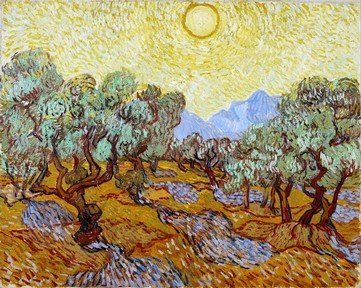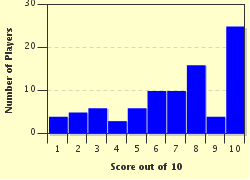Quiz Answer Key and Fun Facts
1. Here we have a sacred baboon of Hamadryas, sculpted by an Italian artist. The sculptor is the younger brother to an automobile manufacturer. Who gained fame for sculpting lions, panthers, elephants and other wild life?
2. We move on to a very confusing painting. A nude lady lies asleep on a rock floating in the air. A pomegranate bursts open, liberating a fish. Out of the fish's mouth two tigers leap towards the nude lady, and one of the tigers drops a gun. In the background we see an elephant on very long, very thin paws walking by. Who painted this "Dream Caused by the Flight of a Bee around a Pomegranate a Second Before Awakening"?
3. The next drawing is something one may look at for hours before grasping exactly what is going on. On top there is one goose, very elaborate. In the next lines there are more geese, with less detail, and suddenly the focus shifts to the fish formed by the empty spaces between the geese. The bottom line is a very elaborate fish. You're looking at "Sky and Water", one of the many interesting drawings made by a Dutch artist, also known for his works with startling perspective. Who was this artist?
4. In the "Still Life with Crab, Poultry and Fruit" by Frans Snyders, there is a live predator looking avidly at the poultry. Which animal is about to take away one of the elements of the painting?
5. In Rubens' painting of "Adam and Eve", you might expect to find a snake. Are there any other animals in this painting?
6. Diego Velazquez has left us several hunting portraits of members of the Spanish Habsburg family. Which animal did Velazquez paint in the hunting portraits of Cardinal Infante Don Fernando, King Philip IV and the young Prince Baltasar Carlos?
7. Let's take a look at "Olympia" (1863). It shows us a nude woman reclining on a divan. Oh come on guys, don't keep staring at that particular place, but shift your regard to her bare feet. You'll find (by looking very carefully) a black cat at Olympia's feet. Who scandalized Paris with this painting?
8. In the painting "Madonna del Cardellino" by Raphael, we see Mary with the young boys John the Baptist and Jesus Christ. Mary is reading a book, and John holds a little bird in his hands. Jesus reaches out to stroke the bird. Which bird is mentioned in the title of this painting?
9. Which of the following equestrian statues was made during the Roman Empire, survived the ages and can still be seen in Rome?
10. "Birds of America" is a famous compendium, published in episodes between 1827 and 1839. It includes delicate paintings of all birds discussed, painted by the author himself. Who was the artist who had instant success with this elaborate work?
Source: Author
JanIQ
This quiz was reviewed by FunTrivia editor
looney_tunes before going online.
Any errors found in FunTrivia content are routinely corrected through our feedback system.

